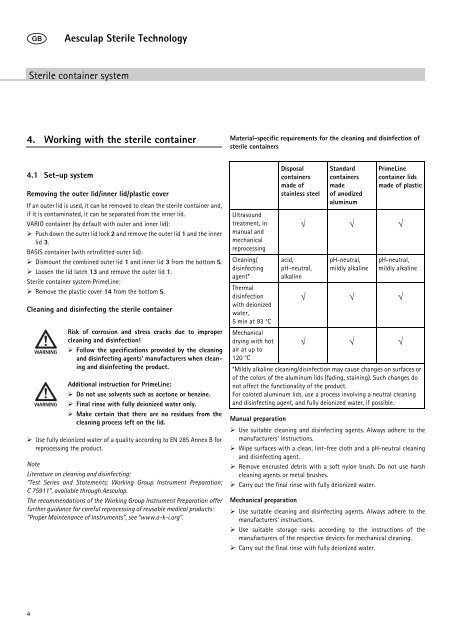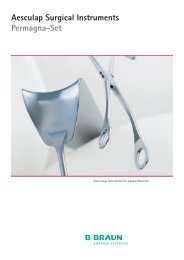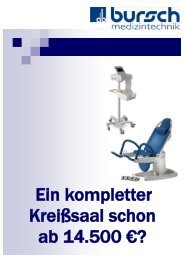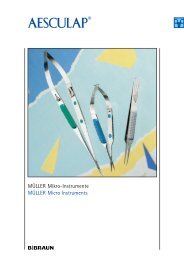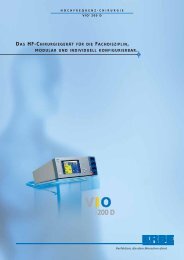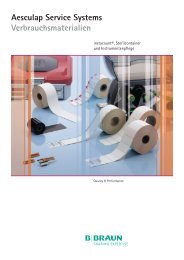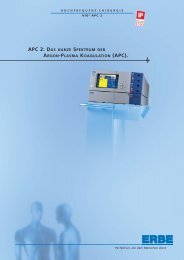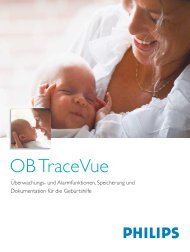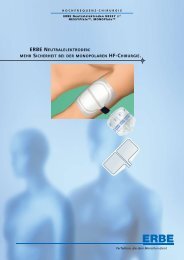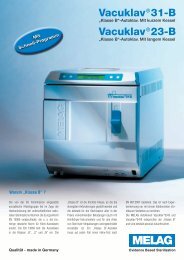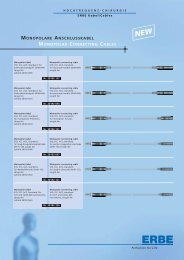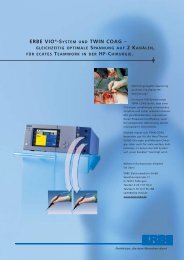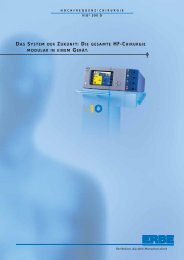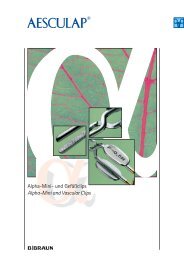Aesculap Sterile Technology Primeline
Aesculap Sterile Technology Primeline
Aesculap Sterile Technology Primeline
Create successful ePaper yourself
Turn your PDF publications into a flip-book with our unique Google optimized e-Paper software.
4<br />
<strong>Aesculap</strong> <strong>Sterile</strong> <strong>Technology</strong><br />
<strong>Sterile</strong> container system<br />
4. Working with the sterile container<br />
4.1 Set-up system<br />
Removing the outer lid/inner lid/plastic cover<br />
If an outer lid is used, it can be removed to clean the sterile container and,<br />
if it is contaminated, it can be separated from the inner lid.<br />
VARIO container (by default with outer and inner lid):<br />
� Push down the outer lid lock 2 and remove the outer lid 1 and the inner<br />
lid 3.<br />
BASIS container (with retrofitted outer lid):<br />
� Dismount the combined outer lid 1 and inner lid 3 from the bottom 5.<br />
� Loosen the lid latch 13 and remove the outer lid 1.<br />
<strong>Sterile</strong> container system PrimeLine:<br />
� Remove the plastic cover 14 from the bottom 5.<br />
Cleaning and disinfecting the sterile container<br />
WARNING<br />
WARNING<br />
Risk of corrosion and stress cracks due to improper<br />
cleaning and disinfection!<br />
� Follow the specifications provided by the cleaning<br />
and disinfecting agents’ manufacturers when cleaning<br />
and disinfecting the product.<br />
Additional instruction for PrimeLine:<br />
� Do not use solvents such as acetone or benzine.<br />
� Final rinse with fully deionized water only.<br />
� Make certain that there are no residues from the<br />
cleaning process left on the lid.<br />
� Use fully deionized water of a quality according to EN 285 Annex B for<br />
reprocessing the product.<br />
Note<br />
Literature on cleaning and disinfecting:<br />
“Test Series and Statements; Working Group Instrument Preparation;<br />
C 75911”, available through <strong>Aesculap</strong>.<br />
The recommendations of the Working Group Instrument Preparation offer<br />
further guidance for careful reprocessing of reusable medical products:<br />
“Proper Maintenance of Instruments”, see “www.a-k-i.org”.<br />
Material-specific requirements for the cleaning and disinfection of<br />
sterile containers<br />
Ultrasound<br />
treatment, in<br />
manual and<br />
mechanical<br />
reprocessing<br />
Cleaning/<br />
disinfecting<br />
agent*<br />
Thermal<br />
disinfection<br />
with deionized<br />
water,<br />
5 min at 93 °C<br />
Mechanical<br />
drying with hot<br />
air at up to<br />
120 °C<br />
Disposal<br />
containers<br />
made of<br />
stainless steel<br />
acid,<br />
pH-neutral,<br />
alkaline<br />
Standard<br />
containers<br />
made<br />
of anodized<br />
aluminum<br />
PrimeLine<br />
container lids<br />
made of plastic<br />
√ √ √<br />
pH-neutral,<br />
mildly alkaline<br />
pH-neutral,<br />
mildly alkaline<br />
√ √ √<br />
√ √ √<br />
*Mildly alkaline cleaning/disinfection may cause changes on surfaces or<br />
of the colors of the aluminum lids (fading, staining). Such changes do<br />
not affect the functionality of the product.<br />
For colored aluminum lids, use a process involving a neutral cleaning<br />
and disinfecting agent, and fully deionized water, if possible.<br />
Manual preparation<br />
� Use suitable cleaning and disinfecting agents. Always adhere to the<br />
manufacturers’ instructions.<br />
� Wipe surfaces with a clean, lint-free cloth and a pH-neutral cleaning<br />
and disinfecting agent.<br />
� Remove encrusted debris with a soft nylon brush. Do not use harsh<br />
cleaning agents or metal brushes.<br />
� Carry out the final rinse with fully deionized water.<br />
Mechanical preparation<br />
� Use suitable cleaning and disinfecting agents. Always adhere to the<br />
manufacturers’ instructions.<br />
� Use suitable storage racks according to the instructions of the<br />
manufacturers of the respective devices for mechanical cleaning.<br />
� Carry out the final rinse with fully deionized water.


